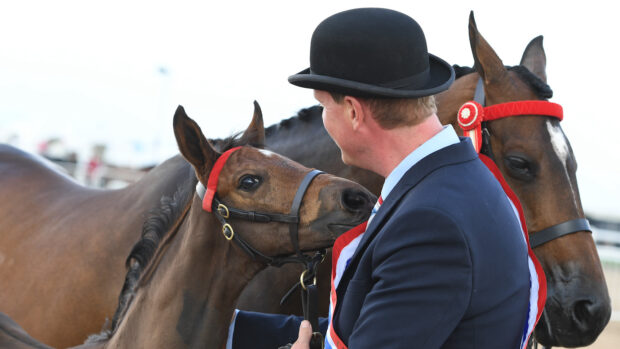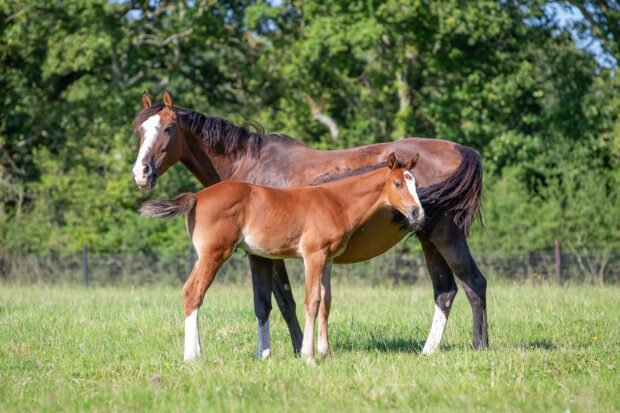More articles on broodmares
Get feeding advice
Most owners who breed from their working mares are aware of the nutritional requirements of pregnancy and will take care to provide for their mare through that time. But what are her requirements after foaling? And what will she need so she can return to work fit and healthy?
Before a foal is born, it relies on the mare for all his growth and development needs. After birth, and until it is about six weeks old, the foal still relies on her – only now it is growing faster and burning more energy.
Dietary requirements
The efficiency of nutrient transfer through milk is not as good as it is through the blood (the nutritional source for the foal in utero), so the lactating mare needs to take in more to provide the same amounts – in fact, her requirements increase by 75%.
At peak lactation rate (six to eight weeks after foaling), an average-sized mare (500-550kg) will produce up to 20 litres of milk daily. The dietary areas to consider are energy, protein, calcium, vitamins and minerals.
Energy and protein
The mare needs to be fed at a sufficient level to keep her in good, but not fat, condition. Studies show that obesity in mares can have a negative effect on growth rates in the youngster. However, inadequate nutrition is detrimental to both mare and foal.
If the mare is not receiving enough, she will first use her own body reserves to maintain milk production. If low-energy intake continues, milk production will drop away and the mare will become thin and emaciated.
Weight loss is also a consideration if the mare is to return to the stallion, as fertility rates can be affected. Monitor her weight regularly and, while some weight loss is inevitable, especially in mares that milk very well, try to feed so that her weight does not change significantly.
In practice, this means feeding up to three per cent of bodyweight in a mixture of forage and concentrates – although this will vary depending on the individual mare. Digestible energy levels of approximately 2.3Mcal/kg and crude protein levels around 12% are appropriate for most lactating mares.
Calcium and phosphorous
After energy and protein, the most important nutrient is calcium, required for healthy bone and muscle growth and development. Calcium requirements increase post-natally to 50-60g daily for an average-sized mare. However, for efficient absorption, it is important that calcium is fed with phosphorous, at a ratio of around 1.5-2:1 (Ca:P) — supplementing with di-calcium phosphate will ensure that the correct ratio is fed.
Feeding phosphorous with calcium is particularly important for the mare at grass because pasture rarely contains sufficient levels of phosphorous for healthy lactation.
Bear in mind that adequate calcium and phosphorous levels are particularly important for the older mare because aged equine bones, like human bones, are susceptible to osteoporosis.
Vitamin intake
A broad spectrum of vitamins is necessary for general health and vitality, but vitamins A and D are particularly important for the lactating mare.
For mares foaling naturally in the spring and summer, fresh pasture and exposure to sunlight should provide the necessary levels of these vitamins. For early foaling mares (such as those seen in racing and some competition yards), supplementing the diet with cod liver oil will provide additional vitamins A and D.
Copper and other minerals
In recent years, much discussion has been given to copper and its role in cartilage formation and joint health. As we know that early joint health in the foal is an indication of joint health in the adult animal, this is an area worth investigating. Unfortunately, studies have been inconclusive and the most likely theory seems to be that supplementing the mare with additional copper has little or no effect on copper levels in her blood or milk, or on the levels passed to the foal.
It is recommended that the diet of the mare — and the foal, when creep feeds are introduced — contains sufficient, but not excessive, levels of copper. All other minerals also need to be present in the diet at standard maintenance levels for optimum growth and general health.
Your best plan is to keep it simple: commercially produced supplements are available that cover all the micro-nutrient requirements of the mare and youngster. These contain calcium, phosphorous and copper on a broad-based supplement of vitamins and minerals to ensure all requirements are met without excess levels of one nutrient being fed to the detriment of others. Remember, no single nutrient works alone and the balance is what’s important, so avoid combining products that aren’t designed to go together.
Supplying water
Water is essential in any diet but of paramount importance to the lactating mare. A clean supply of water should always be available, as limited water intake can significantly reduce milk yield, or even dry it up altogether, in a couple of days.
Looking for more articles on broodmares?
Get feeding advice now



